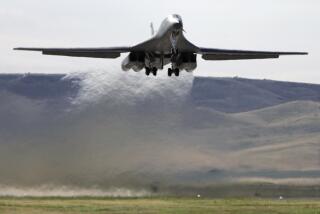The Most Advanced--and Expensive--U.S. Bomber Sits Out the War : Aviation: The sleek B-1 sulks on the ground at home while the ungainly B-52 tackles the Iraqis in Kuwait.
WASHINGTON — In its first week, the Persian Gulf War was a spectacular showcase for the high-tech weaponry of the 21st Century--with one conspicuous exception. The nation’s most advanced bomber, the B-1, stayed home.
The Strategic Air Command says the $280-million-a-copy aircraft, the most expensive warplane currently in any arsenal, cannot be spared from the U.S. strategic deterrent. That is, it must remain poised to drop nuclear bombs on the Soviet Union in case the Cold War is somehow rekindled in the days ahead.
But there is another reason the B-1 cannot go to war in the Persian Gulf: It was grounded last month after engine fan blades broke twice. The Air Force says it does not know when the plane will be allowed to resume flying.
While the sleek B-1, the bomber pilot’s answer to the fast and flamboyant fighter jet, sulks on the ground, the ungainly B-52, a 32-year-old weapon that is years senior to most members of its crews, is pummeling Saddam Hussein’s prized Republican Guard in Kuwait.
The Pentagon bought 100 B-1s, with delivery beginning in 1985, at a total cost of $28 billion. Three of the planes have since crashed.
When the Air Force was trying to sell the B-1 program to Congress and the public, the supersonic bomber was described as the workhorse of the future, a dual-role warplane that could drop nuclear bombs one day and plaster Third World targets the next.
The 1990 U.S. Air Force Almanac, published last May by Air Force Magazine, is rhapsodic in its description of the B-1.
“Ninety of the 97 currently available B-1Bs are assigned to a dual-role, nuclear-theater mission, each with three weapons bays providing the flexibility to carry long- and short-range nuclear air-to-surface missiles, nuclear and conventional gravity bombs, mines, other weapons or additional fuel, as required,” the magazine said.
But when asked why the B-1 was absent from the war, Capt. Don Planalp, a Strategic Air Command spokesman in Omaha said: “The primary role of the B-1B is the strategic deterrent mission which remains in spite of the war in the gulf. When we are asked to provide conventional bombing capabilities, we naturally go to B-52 units that are dedicated to that mission.”
A Pentagon spokesman said the B-1 has been tested and certified to carry only the 500-pound Mark 82 bomb while the B-52 is capable of delivering 500-pound, 750-pound, 1,000-pound, 2,000-pound bombs, Harpoon anti-ship missiles and maritime mines.
Pentagon critics generally agree that there was no need to send the B-1 to the gulf; the B-52 is more than adequate to the task. But some of the critics also suggest there was no need to build the B-1 in the first place.
“It is the most expensive system we have and it was designed for a nuclear war,” said retired Rear Adm. Eugene J. Carroll, deputy director of the Center for Defense Information, an independent think tank that is often critical of the Pentagon.
“To risk 97 of these precious nuclear bombers just isn’t warranted,” he said. “There is no point in committing this weapon in a war which can be fought quite well with more humble equipment.”
The B-1, built by Rockwell International at its plant in Palmdale, has been a center of controversy since it was on the drawing boards two decades ago. When Jimmy Carter was President, he canceled the project in 1977, concluding that B-52s equipped with air-launched cruise missiles could do everything the B-1 could do at a fraction of the cost.
Although he did not say so then, Carter said later that he believed the B-52s could last until the B-2 Stealth bomber is fully operational late in this decade.
Ronald Reagan made the cancellation of the B-1 the centerpiece of his charge that Carter had weakened the national defense. Reagan reinstated the project after he defeated Carter in the 1980 election.
More to Read
Sign up for Essential California
The most important California stories and recommendations in your inbox every morning.
You may occasionally receive promotional content from the Los Angeles Times.









